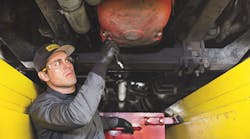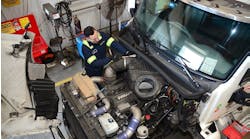Starting in 2006, the U.S. Environmental Protection Agency (EPA) began enforcing more stringent regulations on diesel fuel and diesel engine oils for on-highway diesel vehicles in order to reduce vehicle emissions. Between 2006 and 2010, ultra low sulfur diesel (ULSD) fuel was phased in to reduce the amount of sulfur from 500 to 15 parts per million (ppm).
This switch to ULSD fuel would better enable the use of catalyst-based emission control devices such as the diesel particulate filter (DPF) to assist in meeting the EPA’s new emissions standards for particulate matter (PM) and NOx. In 2007, these new emissions standards would begin to take effect as that was also the year DPFs were introduced to on-highway heavy duty diesel engines.
Prior to 2007, the emissions standards were set at limits of 2g/bhp-hr (grams per brake horsepower hour) for NOx emissions and 0.1g/bhp-hr for particulate matter emissions. Beginning with 2007 model year vehicles, a new limit of 0.01g/bhp-hr for particulate matter emissions went into full effect, while the new limit of 0.2g/bhp-hr for NOx emissions was phased in between 2007 and 2010.
In addition to ULSD fuel and DPFs, a new diesel engine oil category was introduced: CJ-4. According to the American Petroleum Institute (API), CJ-4 was designed to help on-highway diesel vehicles meet the 2007 emissions standards.
According to the API, “CJ-4 oils are effective at sustaining emission control system durability where particulate filters and other advanced aftertreatment systems are used. Optimum protection is provided for control of catalyst poisoning, particulate filter blocking, engine wear, piston deposits, et cetera.”
It was the introduction of this new engine oil category that enabled DPFs to function efficiently. It is important for fleets to understand how the latest formulation of engine oil is changing to optimize the performance of DPFs and the aftertreatment system overall.
Diesel engine oils now
In 2016, two new categories of engine oil were introduced: CK-4 and FA-4.
“These oils had better viscosity control. They also had better oxidation stability, and they're able to stay in the engines longer,” says Paul Cigala, commercial vehicle lubrication applications engineer for ExxonMobil. “All OEMs raised their oil drain intervals with the introduction of these two products. Also, with the acceptance of lower viscosity oils, 10W-30s and 5W-30s, as well as the introduction of FA-4 oils, we're seeing fuel economy benefits recognized across the fleets as well.”
The API states that CK-4 oils, much like the CJ-4 oils they replace, and FA-4 oils, the first in the ‘F’ category for fuel efficient oils, are efficient at supporting the durability of the DPF and providing “enhanced protection against oil oxidation, viscosity loss due to shear, and oil aeration as well as protection against catalyst poisoning, particulate filter blocking, engine wear, piston deposits, degradation of low- and high-temperature properties, and soot-related viscosity increase.”
Though similar in many ways, CK-4 oils and FA-4 oils are notably different because CK-4 oils are backward compatible while FA-4 oils are not. This means CK-4 oils can be used in place of previous oils in the same category, such as CJ-4, CI-4, CI-4 Plus, etc.
“[Another] distinction between the two is around the high temperature, high shear [HTHS] viscosity,” says James Booth, commercial sector manager at Chevron. “Ideally you want an oil which isn’t too thick where you waste energy trying to push through it and isn’t too thin that metal surfaces rubbing against one another touch and wear. High temperature and high shear conditions such as those found in the engine power cylinder are particularly important for this balance. FA-4 has a lower high temperature, high shear than CK-4, and the benefit of that is when you take low viscosity oil and design an engine around that, [you] get more fuel efficiency from it.”
DPF performance
Since the introduction of CJ-4 oils in 2006, engine oil manufacturers have been placing limits on certain chemicals in the oils to increase their compatibility with the DPF, says Mark Betner, heavy duty lubricant manager for Citgo. Those chemical limits have remained in place for CK-4 and FA-4 oils as well. By limiting harmful chemicals and working to lower oil viscosity, engine oil manufacturers have found ways to optimize the performance of the DPF and aftertreatment system as a whole with improved engine oil formulations.
SAPS
Since the introduction of DPF-compatible engine oils, engine oil manufacturers have needed to be careful of how much sulfated ash, phosphorous, and sulfur (SAPS) is present in the oil. While phosphorous and sulfur are beneficial in small amounts, aiding in wear-protection, too much of either could cause issues with the DPF or aftertreatment system overall. As for sulfated ash, this is the byproduct of the burning of metallic engine oil additives. High amounts of sulfated ash will clog the DPF, hindering DPF performance and causing it to require increased maintenance.
“Diesel engines that utilize a diesel particulate filter should [use] an oil that is a ‘low SAPS,’” says Dan Arcy, global OEM technical manager for Shell Lubricants. “Since 2007, all on-road heavy duty diesel engine manufacturers recommend the use of oils that have less than 1 percent sulfated ash.”
As for phosphorus and sulfur amounts, they are limited to 0.12 percent and 0.4 percent, respectively.
If the SAPS rise above those levels, problems will arise.
As mentioned above, excessive amounts of sulfated ash will clog the DPF. A clogged DPF means the filter cannot properly perform its job of capturing particulate matter and ash to ensure a less harmful exhaust is released into the environment. It also means more frequent cleanings of the DPF or a greater chance of damage to the DPF, resulting in increased downtime for the fleet.
Fleets should be aware, though, that all engine oils have a certain amount of metallic compounds that will lead to sulfated ash, says Chevron’s Booth. Any ash-forming compounds in the engine oil will eventually hinder DPF performance. However, using engine oils with 1 percent or less sulfated ash will decrease the frequency of necessary DPF maintenance.
Increased amounts of sulfur and phosphorus do not directly impact the DPF but will affect the aftertreatment system as a whole. More sulfur or phosphorus in the engine oil can cause poisoning of the catalysts, says ExxonMobil’s Cigala, which will render the catalysts ineffective.
If the catalysts are not working properly, then neither can the DPF or aftertreatment system overall.
Though lower levels of SAPS are best in the engine oils, ExxonMobil’s Cigala warns that as these levels are lowered, fleets must be aware that durability and longevity of the engine and aftertreatment system could be negatively impacted if the formulation of the engine oil is not properly compensated to make up for the wear-protection provided by those additives.
Engine oil consumption
In order to keep the DPF and all the other components of the aftertreatment system protected, the engine oil must have good viscosity control.
“Viscosity dictates the separation [fluid film thickness] between engine parts moving relative to one another,” Booth says. “If an engine oil shears down significantly, this can result in an oil film that is too thin to protect interacting surfaces from wearing against one another. One such area is the piston ring and cylinder liner. If wear occurs between the ring and liner, then more oil can reach the combustion chamber and be consumed.”
Additionally, due to the higher temperatures newer engines are running, oxidation of the engine oil can occur, cutting down on the oil’s longevity, Cigala says.
Oxidation can cause deposits to develop on the piston.
“Piston deposits can cause sticking of the piston ring, meaning it can’t seal properly, or wear can ensue – deposits are abrasive and make gaps between parts wider,” Booth says. “In either case, more engine oil can reach the combustion chamber, and thus be consumed or burned in the combustion process. In both cases, oxidation and viscosity-loss, the consequence is increased oil consumption through the combustion chamber resulting in greater ash loading in the exhaust stream, and thus clogging in the DPF.”
CK-4 and FA-4 engine oils have the viscosity and oxidation control fleets need, as well as the benefit of better fuel economy.
According to Cigala, 15W-40 engine oils were pretty much standard across the industry before CK-4 and FA-4 oils were introduced. The benefits of using these lower viscosity oils are a 1 to 1.5 percent fuel economy benefit when going from 15W-40 oil to a 10W-30 oil, and an additional 0.5 to 1 percent fuel economy benefit when going to an FA-4 oil in either a 10W-30 or 5W-30. He notes lower viscosity oils make engine starts easier in the winter, and though some fleets believe higher viscosity oils provide better wear-protection, the lower viscosity oils have to pass the same API testing for wear-protection.
DPF maintenance
Maintaining a DPF involves more than just cleaning the DPF after it’s clogged. Fleets also need to use the proper engine oil to keep the DPF and aftertreatment system as a whole running smoothly and efficiently.
“The most important thing is piston cleanliness,” says Shell’s Arcy. “This will have [a] direct effect on DPF maintenance. There are several factors that determine DPF maintenance intervals and overall service life. The main factor is the amount of oil that is burned. Controlling piston cleanliness, which in turn helps control oil consumption, will have a big effect on DPF service life. Diesel engine oil must provide strong piston cleanliness, otherwise oil consumption will be high, and DPF ash buildup will be accelerated. A clean engine with clean pistons will prevent oil from passing by the rings and entering the combustion chamber and being consumed [burned].”
Since the burned oil contains non-combustible materials, Arcy explains, ash accumulates in the DPF, with the amount of ash directly correlating to the amount of oil consumed as well as the amount of “ash forming components within the oil, such as detergents and anti-wear components.”
Engines inherently consume engine oil. There are performance characteristics of oil within the engine that can lessen or worsen the level of consumption, but the sulfated ash content is the greatest challenge impacting DPF clogging. According to the research conducted by Chevron, 90 percent of DPF clogging is caused by engine oil-related ash, and regardless of the engine oil used, Booth says a certain amount of the engine oil will be consumed.
It is important for fleets to understand that an engine oil with low-SAPS, good viscosity control, and that follows the recommendations of their vehicles’ OEMs will have the greatest overall impact on proper DPF and aftertreatment system performance.




